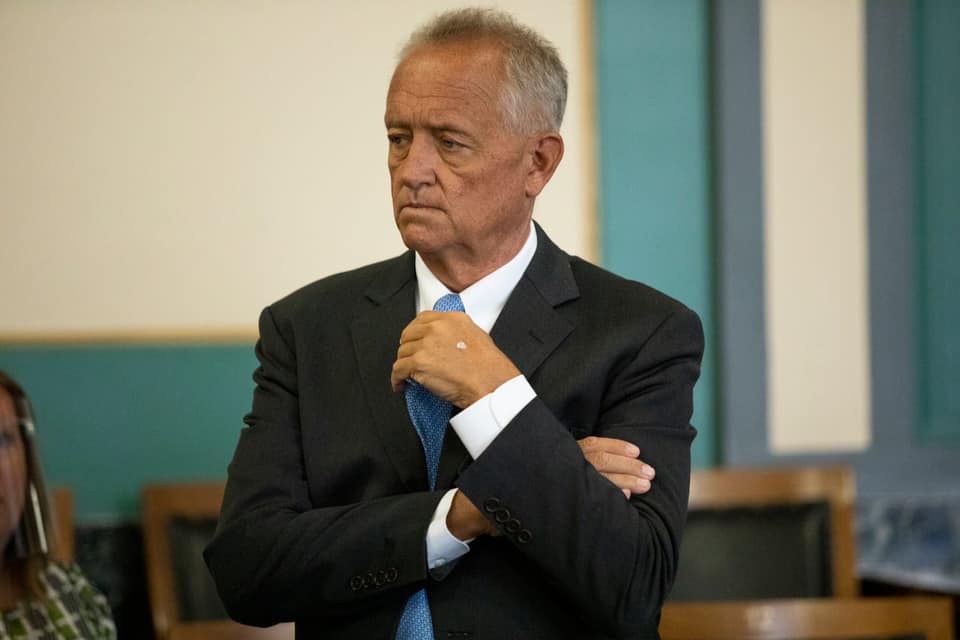In Ohio’s Redistricting Redo, a New Justice and a New Speaker Will Steer the Ship
But the likeliest outcome remains a new round of aggressive Republican gerrymanders.
Daniel Nichanian | January 12, 2023


It’s Groundhog Day in Columbus. After a protracted redistricting battle last year that saw Republicans adopt a relentless barrage of gerrymanders, only to have them repeatedly struck down by the state supreme court, Ohio must again draw new maps in advance of the 2024 elections.
But the cast of characters who will steer the process got reshuffled last week, with two newcomers set to play influential roles.
Meanwhile, the Republican chief justice who had sided with Democrats in last year’s gerrymandering cases exited the stage on Dec. 31.
Some Democrats hope that they secured a new Republican ally—this time in the legislature, where Jason Stephens was unexpectedly elected Speaker thanks to a bipartisan coalition that included all House Democrats—and that this may mitigate the maps’ partisan bias upfront, before they reach judicial review. But once they do, the GOP’s odds of securing favorable rulings for its gerrymanders has shot up dramatically due to a new conservative justice.
“I suspect the political tricks to undermine democracy will go the distance,” said Desiree Tims, the head of Innovation Ohio, a progressive organization that lobbies for fair maps and is part of Ohio’s Equal Districts coalition. “The redistricting process should unfold in a democratic way, which has not been our experience in Ohio.”
Joe Deters, the new justice who shifts the high court to the right
Two days before Christmas, Republican Governor Mike DeWine filled a vacancy on Ohio’s supreme court by appointing Joe Deters, the tough-on-crime prosecutor of Hamilton County (Cincinnati) who is close to the state’s GOP power brokers. “Joe Deters has the right combination of experience, legal knowledge, and passion for public service that will serve the citizens of Ohio well,” DeWine said. Deters was sworn-in this past Saturday, just a week after Justice Maureen O’Connor, one of the court’s anti-gerrymandering crusaders, was forced to retire due to her age.
The switch greatly alters the court’s ideological balance and likely flips it into a majority willing to uphold Republican gerrymanders.
“It suggests that the minority will become the majority, and there will not be the check on the mapmakers that there was during the 2021-2022 mapmaking,” said Catherine Turcer, who leads Common Cause Ohio, a voting rights organization, about Deters’s arrival on the court.
Katy Shanahan, who last year worked as the Ohio state director of All On the Line, an anti-gerrymandering group, agrees. “Now the state supreme court has an ultraconservative four to three majority, which to me signals that [Republicans] will get a greenlight on whatever they want to pass,” she said.
O’Connor, a Republican, sided with the court’s three Democratic justices last year in a series of rulings that invalidated the congressional and legislative maps adopted by the GOP-controlled Ohio Redistricting Commission because they “unduly favored” the Republican Party in violation of the state constitution. The three other Republican justices voted to sustain the maps but they were on the losing side of the repeated 4-3 decisions.
“When the dealer stacks the deck in advance, the house usually wins,” the majority wrote in January 2022, in the decision that struck down the GOP’s first congressional map. Over and over again after that—the court invalidated congressional and legislative maps in seven separate rulings between January and July—the justices faulted Republican map-drawing for packing Democratic voters into just a few districts while also cracking diverse urban areas to dilute their representation.
Still, Republican lawmakers ignored the court’s rulings and ran out the clock by passing an endless stream of gerrymanders; eventually, a federal court allowed a set of maps drawn by the GOP to be used in the 2022 midterms only, helping solidify Republican supermajorities. And with a new round of redistricting now looming, last year’s court majority has unraveled: O’Connor reached the mandatory retirement age, Republican incumbents swept November’s supreme court races, and DeWine added a political ally—Deters—to the court.
Deters has no track record on matters that involve redistricting: He has worked as a prosecutor for much of the past forty years, with the exception of a brief, scandal-tarred stint as state Treasurer in the early 2000s. But many state observers told Bolts that they harbor little uncertainty over how Deters will approach those cases.
That’s in part due to Deters’s personal proximity to Mike DeWine, the governor, and to Pat DeWine, the governor’s son and a justice on the state supreme court. Besides donating to the DeWines, Deters has exchanged favors with the family. In 2017, Pat DeWine asked Deters to give his college-aged son an internship in the prosecutor’s office and Deters obliged, as Cincinnati’s City Beat reported at the time.
Deters and Pat DeWine faced ethics complaints and calls for investigation over this internship, but Deters defended the arrangement, insisting it was proper for him to do a favor for a friend.
Now, the two friends will sit on the supreme court together, called upon to decide the fate of initiatives that Mike DeWine is involved in. Last year, Pat DeWine voted to uphold the gerrymanders of Ohio’s redistricting commission, even though his father is a member of the panel, voted to approve the maps, and has said that he believes the maps passed constitutional muster; Pat DeWine rejected calls that he recuse himself from last year’s cases.
Critics of the state’s redistricting process say all of these intricate relationships will now affect the fate of upcoming legal disputes over district boundaries.
“Mike DeWine knows exactly who he’s appointing to that court. You’re not going to waste a political appointment, given the stakes of, among other things, the redistricting process to someone who you don’t know for sure how you think they should vote on those issues,” said Shanahan. “I think anyone suggesting otherwise doesn’t understand politics.”
“Joe Deters will not be like Chief Justice Maureen O’Connor,” she added.
Deters’s record on criminal justice also reveals a very different outlook than O’Connor brought to the court. Last year, O’Connor sided with Democratic justices in a case that lightly reformed the state’s bail system but provoked fierce backlash from state Republicans. Deters responded by fueling a conservative counter-offensive against bail reform, which resulted in a constitutional amendment that expanded pretrial detention in November.
Deters has long cultivated this tough-on-crime persona, including on issues that the court will likely confront in the future, from calling a group of defendants in a 2015 case “soulless and unsalvageable” to staunchly championing the death penalty.
“What we always hope for the courts is that party labels don’t matter, and that was certainly the case with Maureen O’Connor,” Turcer said. “But I think it’s very important that we be realistic about that as well.”
Jason Stephens, the new speaker who may introduce some uncertainty into redistricting
Some Ohio politicians did defy partisan expectations last week just a few blocks from the supreme court, in the state capitol.
Largely sidelined in recent years, Democrats injected themselves into legislative proceedings when their House members coalesced with a third of the GOP caucus to elect Stephens as state Speaker. Stephens defeated the candidate who was expected to prevail, a very conservative lawmaker selected by most of his fellow Republicans.
The shock result led some Democrats and some anti-gerrymandering advocates to speculate that it may herald an “honest effort to get bipartisan maps,” as The Columbus Dispatch reported last week.
“We are certainly encouraged to see a speaker that was chosen by members of both parties, and we hope that that bipartisanship will continue in creating district plans that truly serve the people,” Jen Miller, head of the League of Women Voters of Ohio, told Bolts.
But no concrete promise has been reported between Stephens and Democrats on redistricting or any other issue. Allison Russo, the chamber’s Minority Leader, did not reply to a request for comment on whether Stephens made any commitments in exchange for Democratic votes.
Stephens’s office also did not reply to requests for an interview.
The new Speaker himself has a broadly conservative record as a legislator, including supporting new restrictions on abortion and voting for a legislative package that restricted ballot access in December. That package, which was signed into law by Mike DeWine last week and has been strongly denounced by voting rights groups, restricts the availability of ballot drop boxes, eliminates a day of in-person early voting, and makes the state’s voter ID requirements more burdensome by disallowing some forms of identification, among other changes.
A number of advocates interviewed by Bolts cautioned that they had no high hopes for Stephens’s leadership. Even if he were to be interested in toning down gerrymandering, they said, he has his work cut out for him given the recent records of Ohio’s other Republican officials.
“I’m cautiously pessimistic about a deal between the Ohio Democrats and Republicans,” said Tims. “The Republicans have shown us their hand every single time throughout the process. It has never been a fair shake.”
“It’s a little hard to not feel like we’re just in another Lucy and the football moment,” Shanahan said about Stephens securing a promotion thanks to Democrats. “I hope that we’re not, I hope Lucy does hold down that football…, I hope that what comes out of this is positive movement away from the fringe extremes that our state legislature has been residing in for years. I’m skeptical, but I hope to be proven wrong.”
The upcoming map-drawing will be handled by the redistricting commission, a panel made up of the governor, auditor, and secretary of state—all of whom are currently Republicans—plus four members that represent the four legislative leaders in each chamber. (The leaders typically serve on the commission themselves.) That means that, even if Stephens were to resist aggressive proposals, there would be four other Republicans on a seven-person body.
Those include Matt Huffman, the state Senate President who played a lead role in ramping up the scope of gerrymandering last year, and Frank LaRose, the secretary of state who last year floated impeaching O’Connor from the state supreme court over her redistricting rulings.
But Stephens is still in a position to at least change last year’s dynamic, if not soften the maps, if he so chooses.
Ohio’s outgoing Speaker Bob Cupp played a very aggressive role in 2022 in controlling the mapmaking and in boxing other officials out of much of the process; legislative leaders wield special influence, especially over how their own chamber’s lines are redrawn. Turcer, who described herself as “guardedly optimistic” about the new Speaker, also floated the possibility that Stephens may at least make the redistricting process more transparent.
“This is a systemic problem”
Several Ohio advocates told Bolts that their strongest hope about Stephens was that his bipartisan win may at least kill a controversial change to the state’s referendum process—one that would make it harder to change the redistricting process in the first place.
Late last year, Republicans floated increasing the threshold of passage for citizen-initiated ballot measures from 50 to 60 percent. That would make it far harder for independent groups to secure wins over policies that the legislature fiercely opposes, such as abortion protections. The idea did not pass the legislature in late 2022, leaving a path—for now—for redistricting reform.
Miller of the League of Women Voters and Turcer of Common Cause Ohio each said that their groups were exploring how to champion a new citizen-initiated ballot measure in Ohio to implement an independent redistricting commission, like the ones used in Arizona and Michigan. But neither committed to a timeline for such a push.
In 2015, voting rights groups championed an amendment that put in place the system in use now but Republicans weaponized it in ways that advocates say was unintended. One of the components of that reform was that a map would only be in place for four years, rather than the usual ten, if it failed to gather bipartisan support; it turned out that Republicans in passing their 2022 maps did not care about this constraint, which in fact only gave them the opportunity to refine their lines more frequently. As a result, and no matter what happens in the run-up to 2024, Ohio will yet again need to draw new maps in the lead-up to 2026.
“At some point, there’s an insanity in doing the same thing over and over again,” Turcer told Bolts. “It’s not a matter of new tools—community mapping, citizen engagement, all the different ways that voters can show how their district is manipulated. We’ve tried all that. At this point, we need to actually take the elected officials out of the equation and put this in the hands of an independent insulated citizens commission.”
Federal Democrats mulled institutional protections against gerrymandering when they controlled Congress in 2021 and 2022, but those did not pass due to several senators’ opposition to changing the U.S. Senate’s filibuster rules. “HR1 would have solved a lot of these problems,,” said Tims, referencing the federal legislation, “and because of that failure, voting rights and democracy continue to erode in statehouses across the country.”
“These folks are drunk on power, essentially,” Turcer said of politicians in charge of drawing the maps that keep them in power. “And what do you do with drunks? You take away their keys.”
Sign up and stay up-to-date
Support us
Bolts is a non-profit newsroom that relies on donations, and it takes resources to produce this work. If you appreciate our value, become a monthly donor or make a contribution.


